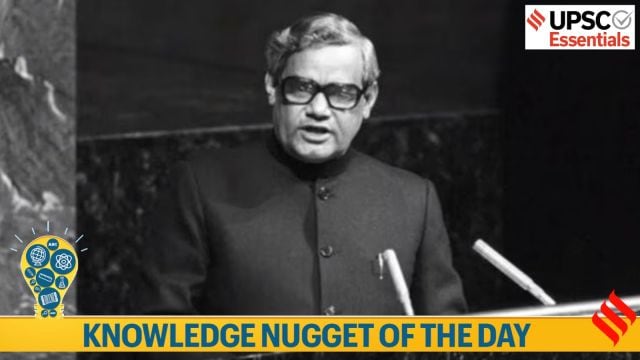Take a look at the essential events, concepts, terms, quotes, or phenomena every day and brush up your knowledge. Here’s your knowledge nugget for today.
Knowledge Nugget: Good Governance Day
Subject: Polity
Why in the news?
Every year, Good Governance Day is celebrated on December 25th. This day aims to raise awareness among citizens about government accountability and effective administration while promoting the practice of “good governance” among civil servants.

Key Takeaways :
1. In 2014, the Union government announced that December 25 would be celebrated as “Good Governance Day.” This day honors the birth anniversary of former Prime Minister Atal Bihari Vajpayee.
2. According to a Good Governance Index Report submitted to the Department of Administrative Reforms and Public Grievances in the Ministry of Personnel, Public Grievances and Pensions, “Good governance can be referred as an effective and efficient process of decision making and the process by which decisions are implemented (or not implemented) keeping the amelioration of citizens as the topmost priority. Resource allocation, creation of formal establishments, setting up rules and regulations etc., are part of achieving this goal.”
Atal Bihari Vajpayee
1. Atal Bihari Vajpayee was born on December 25, 1924 in Gwalior, present-day Madhya Pradesh. A poet-politician, he joined the Rashtriya Swayamsevak Sangh (RSS) in 1939, becoming a pracharak (full-time worker) in 1947. Due to his literary prowess, he began working under Sangh Parivar head Deen Dayal Upadhyaya on various publications.
2. He became the national president of the Jana Sangh, RSS’s new political outfit, in 1968. He held his first major national position as the External Affairs Minister in Morarji’s post Emergency government in 1975. While that government soon fell (in 1977), Vajpayee had earned major plaudits for his tenure, with his UN General Assembly speech in Hindi drawing praise from all quarters.
3. While he first became Prime Minister in 1996 (for 16 days) it was his 1998-1999 and 1999-2004 terms that left a lasting impact on the nation.
Story continues below this ad
4. Under his tenure, India formally became a nuclear power despite significant criticism from the West, ably faced war and peace with Pakistan, undertook massive public welfare projects including Sarva Shikshya Abhiyaan and PM Gramin Sadak Yojana, and ushered in a new era of foreign investment and international relations, especially with the US.
5. When Prime Minister Narendra Modi announced the new “Good Governance Day” in 2014, there were two primary reasons cited. First was to commemorate the life of Atal Bihari Vajpayee.
 Kalyan Singh with Atal Bihari Vajpayee, L K Advani, Kanshi Ram and Mayawati. (Express archives)
Kalyan Singh with Atal Bihari Vajpayee, L K Advani, Kanshi Ram and Mayawati. (Express archives)
6. Second, was to use the day as a way to increase awareness of government services and accountability among people and inculcate “good governance” as a habit for civil servants. The day is celebrated to ensure that the country’s residents are treated fairly by the government and they receive advantages of various government services.
BEYOND THE NUGGET: Good Governance Index and PRAGATI
Good Governance Index
Story continues below this ad
1. The Centre has decided not to release the Good Governance Index 2023, the biennial ranking of states and Union Territories (UTs) scheduled to be released during Good Governance Week (December 19 to December 25), and is now planning to publish the next edition in 2025, The Indian Express has learnt. Tamil Nadu and Gujarat got first place among big states in the 2019 and 2021 rankings, respectively.
2. In 2019, the government launched the Good Governance Index (GGI). The GGI is a scientifically prepared tool based on various parameters of good governance which assess the level of any state at a given point of time and help in shaping future development.
3. GGI is a uniform tool to assess the status of governance and the impact of various interventions by state governments and Union Territories.
4. As per the methodology of the index, states are assessed on their performance in 10 sectors — agriculture and allied sectors, commerce and industries, human resource development, public health, public infrastructure and utilities, economic governance, social welfare and development, judicial and public security, environment and citizen-centric governance.
Story continues below this ad
PRAGATI
1. According to the study, Oxford University’s Saïd Business School in collaboration with the Gates Foundation, reveals how digital governance under the highest level of political leadership can help nations overcome traditional bottlenecks in infrastructure development.
2. PRAGATI (Pro-Active Governance and Timely Implementation) was launched in 2015 by Prime Minister Narendra Modi. It combines leadership with video conferencing, drone feeds, and data management to enable oversight of critical infrastructure.
3. The platform’s impact has helped complete long-delayed projects like segments of National Highway 8 in Maharashtra, the Chenab Bridge in Jammu and Kashmir, which is now the world’s highest rail bridge, and the Bogibeel Bridge in Assam, which had languished for more than a decade before being completed within three years of coming under review in PRAGATI.
Story continues below this ad
(Sources: What is Good Governance Day, and how is it marked?, India’s digital PRAGATI)
For your queries and suggestions write at roshni.yadav@indianexpress.com
The Indian Express UPSC Essentials brings to you the December issue of its monthly magazine. Click Here to read. Share your views and suggestions in the comment box or at manas.srivastava@indianexpress.com
Subscribe to our UPSC newsletter and stay updated with the news cues from the past week. Stay updated with the latest UPSC articles by joining our Telegram channel – Indian Express UPSC Hub, and follow us on Instagram and X.



 Kalyan Singh with Atal Bihari Vajpayee, L K Advani, Kanshi Ram and Mayawati. (Express archives)
Kalyan Singh with Atal Bihari Vajpayee, L K Advani, Kanshi Ram and Mayawati. (Express archives)






























